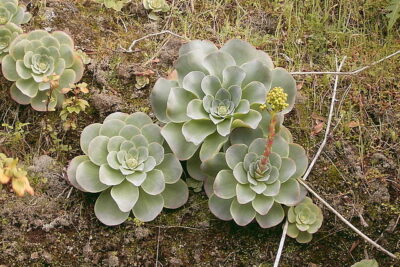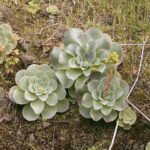
Aerial Roots and Succulent Growth: A Comprehensive Exploration

Aerial roots and succulent growth are two fascinating aspects of plant biology that have captured the attention of scientists and plant enthusiasts alike. Aerial roots are specialized structures that enable plants to absorb moisture and nutrients from the air, while succulent growth refers to the ability of certain plants to store water in their leaves, stems, or roots. Understanding the mechanisms and functions of these adaptations can provide valuable insights into the survival strategies of plants in diverse environments.
We will delve into the world of aerial roots and succulent growth, exploring their evolutionary origins, anatomical features, and ecological significance. We will discuss how aerial roots enable plants to thrive in environments with limited access to soil moisture and nutrients, and how succulent growth acts as a water storage mechanism that allows plants to withstand periods of drought. Additionally, we will explore some notable examples of plants that exhibit these adaptations and examine the cultural and practical uses of aerial roots and succulent plants. By the end of this comprehensive exploration, readers will have gained a deeper understanding of the fascinating world of aerial roots and succulent growth in plants.
- Aerial roots serve as a means for plants to access additional nutrients and water
- Succulent growth allows plants to store water for times of drought
- Aerial roots can be encouraged by misting or providing a humid environment
- Succulent growth can be promoted by providing well-draining soil and limiting watering
- Aerial roots can be pruned if they become too unruly or pose a risk to the plant
- Succulent growth can be controlled by providing adequate sunlight and temperature conditions
- Aerial roots can be utilized for propagation by cutting and planting them in soil
- Succulent growth can be enhanced by providing fertilizer specifically formulated for succulent plants
- Aerial roots can be supported with stakes or trellises to prevent damage or breakage
- Succulent growth can be enhanced by regular pruning to maintain a compact and healthy shape
- Frequently Asked Questions
Aerial roots serve as a means for plants to access additional nutrients and water
Aerial roots, also known as air roots or epiphytic roots, are specialized structures that certain plants develop in order to obtain additional nutrients and water. These roots are different from the traditional underground roots that we typically associate with plants, as they grow above the ground and often dangle in the air.
One of the primary functions of aerial roots is to provide support and stability to the plant. Many epiphytic plants, such as orchids and bromeliads, grow naturally on trees or other structures where they may not have access to sufficient soil or nutrients. In order to survive in these environments, they have evolved aerial roots that can cling to surfaces and anchor the plant securely.
However, aerial roots are not just for support. They also play a crucial role in obtaining the necessary resources for the plant's growth and survival. These specialized roots have the ability to absorb moisture and nutrients directly from the air, allowing the plant to thrive even in nutrient-poor environments.
The structure and adaptations of aerial roots
Aerial roots have unique characteristics that enable them to perform their specialized functions effectively. One notable adaptation is the presence of a spongy tissue known as velamen. Velamen acts as a sponge, absorbing moisture from the air and providing a protective barrier against excessive water loss. This adaptation allows aerial roots to efficiently absorb water even in environments with low humidity.
 Can Fuzzy Kalanchoe Succulents Thrive Indoors?
Can Fuzzy Kalanchoe Succulents Thrive Indoors?Another adaptation of aerial roots is the presence of numerous tiny root hairs on their surface. These root hairs increase the surface area of the root, enhancing its ability to absorb nutrients from the air. Additionally, some aerial roots may develop a specialized structure called a "root cap" at the tip, which protects the root as it grows and helps in penetrating the substrate.
Examples of plants with aerial roots
There are several plants that are well-known for their aerial roots and their ability to grow in unique environments. One such example is the banyan tree (Ficus benghalensis), which is native to India and other parts of Southeast Asia. The banyan tree develops aerial roots that grow downwards from its branches and eventually reach the ground, forming additional trunk-like structures. These roots provide stability to the massive tree and enable it to thrive in diverse habitats.
Another fascinating example is the epiphytic orchid (Orchidaceae family), which is known for its intricate aerial root system. Orchids often grow on the branches or trunks of trees, where they utilize their aerial roots to absorb moisture and nutrients from the air. These roots not only anchor the orchid in place but also contribute to its overall growth and development.
In conclusion
Aerial roots are remarkable adaptations that allow certain plants to thrive in challenging environments. By developing specialized structures and mechanisms, these roots enable plants to obtain additional nutrients and water, ensuring their survival. Understanding the role and structure of aerial roots can provide valuable insights into the fascinating world of plant adaptation and growth.
Succulent growth allows plants to store water for times of drought
One of the remarkable adaptations that plants have developed to survive in arid environments is succulent growth. Succulent plants, such as cacti and certain species of aloe vera, have evolved to store water in their leaves, stems, and roots. This unique feature enables them to endure prolonged periods of drought by conserving and utilizing water efficiently.
One key adaptation that succulents possess is the presence of aerial roots. These specialized roots, also known as adventitious roots, are typically found above the ground and serve multiple purposes. Aerial roots not only provide additional support to the plant but also play a crucial role in water absorption. They have a high capacity to absorb moisture from the air and the surrounding environment, helping the plant supplement its water supply.
Unlike traditional roots that grow underground, aerial roots are equipped with a thick epidermis and a waxy cuticle layer. This protective coating reduces water loss through evaporation and helps the plant retain moisture. Additionally, aerial roots often have a fuzzy or velvety texture, which enhances their ability to trap and retain water droplets from the atmosphere.
 Choosing the Best Habitat for Thriving Succulents: Indoor or Outdoor?
Choosing the Best Habitat for Thriving Succulents: Indoor or Outdoor?The anatomy of aerial roots
Aerial roots exhibit a unique anatomical structure that ensures their effective functioning. These roots have a high concentration of specialized cells known as trichomes, which are responsible for water absorption. Trichomes are small, hair-like structures that cover the surface of the roots, increasing their surface area for enhanced water uptake.
Moreover, aerial roots often possess enlarged, spongy tissues called aerenchyma. These tissues contain air spaces that allow for efficient gas exchange, facilitating respiration in the absence of soil. Aerenchyma also aids in buoyancy, enabling aerial roots to stay afloat in waterlogged conditions.
Benefits of aerial roots
The presence of aerial roots offers several advantages to succulent plants. Firstly, they provide additional structural support, allowing the plant to grow in challenging environments with limited access to soil or rocky terrain. This adaptation is particularly useful in habitats prone to strong winds or frequent disturbances.
Secondly, aerial roots enable the plant to access alternative sources of water. By absorbing moisture from the air and dew, succulents with aerial roots can supplement their water needs during periods of drought or when the soil is dry. This ability to utilize atmospheric water significantly enhances their survival in arid regions.
Lastly, aerial roots contribute to the propagation and reproduction of succulent plants. In some species, these roots can develop into aerial shoots that produce new plantlets or offsets. This clonal reproduction mechanism allows succulents to colonize new areas and increase their population size.
Succulent growth, characterized by the presence of aerial roots, is a fascinating adaptation that enables plants to thrive in harsh, water-scarce environments. These aerial roots not only provide structural support but also serve as efficient water-absorbing organs, helping succulents store and utilize water effectively. Understanding the anatomy and benefits of aerial roots enhances our appreciation for the resilience and survival strategies of these remarkable plants.
Aerial roots can be encouraged by misting or providing a humid environment
 Indoor Succulents: Thriving Tall Plants for Your Home
Indoor Succulents: Thriving Tall Plants for Your HomeAerial roots are fascinating structures that can be found in various types of plants, including epiphytes and some orchids. These roots are unique because they grow above the ground, unlike the typical roots that grow beneath the soil. Aerial roots serve several important functions for the plants that possess them.
Promoting Aerial Root Growth:
If you want to encourage aerial root growth in your plants, there are a few methods you can try. One effective way is to mist the leaves and aerial roots regularly. By providing a humid environment, you mimic the conditions that these plants typically thrive in. Additionally, you can place a tray of water near the plant or use a humidifier to increase the overall humidity levels.
The Benefits of Aerial Roots:
Aerial roots play a crucial role in the survival of certain plants. They serve as anchors, helping the plants attach themselves to trees, rocks, or other surfaces. This allows the plants to access nutrients and moisture that may not be available in the air or on the ground. Aerial roots also aid in the absorption of water and minerals, contributing to the overall health and growth of the plant.
Types of Aerial Roots:
There are several types of aerial roots that you may encounter. One common type is called prop roots, which grow from the lower part of the stem and provide additional support to the plant. Another type is called pneumatophores, which are specialized aerial roots found in swampy areas. These roots help plants like mangroves obtain oxygen from the air since the soil is often oxygen-deprived.
 Can a Violet Queen Succulent Thrive Indoors? Tips for Indoor Care
Can a Violet Queen Succulent Thrive Indoors? Tips for Indoor CareCaring for Aerial Roots:
It's important to provide the necessary care for plants with aerial roots to ensure their well-being. Avoid removing or cutting off these roots, as they are essential for the plant's survival. Instead, gently guide the aerial roots towards a support structure if needed. Regularly check the moisture levels around the roots to ensure they have adequate hydration. Proper lighting and temperature conditions are also crucial for the healthy growth of aerial roots.
In conclusion:
Aerial roots are intriguing structures that contribute to the growth and survival of various plant species. By understanding their functions and providing the right environment, we can appreciate and nurture these remarkable adaptations in our own gardens or indoor spaces.
Succulent growth can be promoted by providing well-draining soil and limiting watering
When it comes to promoting succulent growth, two key factors play a crucial role: well-draining soil and proper watering techniques. Succulents, known for their ability to store water in their leaves and stems, thrive in environments that mimic their natural habitat.
One of the essential components of creating an optimal growing environment for succulents is the choice of soil. Succulents require well-draining soil that allows excess water to escape quickly. This prevents the roots from becoming waterlogged, leading to rot and other issues. A mix of coarse sand, perlite, and potting soil is often recommended to achieve the ideal drainage for succulents.
 Indoor or Outdoor: Choosing the Right Environment for Your Succulents
Indoor or Outdoor: Choosing the Right Environment for Your SucculentsAdditionally, limiting watering is crucial for promoting succulent growth. Succulents are adapted to survive in arid conditions, so overwatering can be detrimental to their health. It is important to let the soil dry out completely between each watering session. This allows the roots to absorb moisture gradually without causing any damage.
Another interesting aspect of succulent growth is their ability to develop aerial roots. Aerial roots are roots that grow above the ground and serve various purposes for the plant. They aid in water and nutrient absorption, provide stability, and help anchor the plant to different surfaces.
Understanding the role of aerial roots in succulent growth
Aerial roots play a significant role in the growth and survival of succulents. These specialized roots enable succulents to adapt to diverse environments and ensure their overall well-being. Here are some key functions of aerial roots:
- Water absorption: Aerial roots have the ability to absorb moisture from the air, allowing succulents to thrive even in areas with limited ground moisture.
- Nutrient uptake: Along with water absorption, aerial roots also aid in the absorption of nutrients present in the surrounding environment. This helps succulents fulfill their nutritional requirements.
- Stability: Aerial roots play a crucial role in anchoring succulents to various surfaces, such as trees or rocks. They provide stability and prevent the plant from being uprooted during strong winds or heavy rainfall.
- Propagation: Aerial roots can also serve as a means of reproduction for some succulent species. They can produce new plantlets, which eventually grow into independent plants.
Overall, aerial roots contribute significantly to the growth and resilience of succulents. They are a fascinating adaptation that allows these plants to thrive in a variety of challenging environments.
Aerial roots can be pruned if they become too unruly or pose a risk to the plant
When it comes to aerial roots, sometimes they can grow in such a way that they become too unruly or even pose a risk to the overall health of the plant. In such cases, pruning becomes necessary to maintain the plant's well-being.
Pruning aerial roots should be done with caution and proper knowledge of the plant's needs. It is important to identify which roots need to be pruned and which ones should be left untouched. Aerial roots play a vital role in providing support and absorbing nutrients for the plant, so indiscriminate pruning can have negative consequences.
 Can Succulents Survive Outdoors Year-Round?
Can Succulents Survive Outdoors Year-Round?Here are some guidelines to follow when pruning aerial roots:
- Assess the situation: Take a close look at the aerial roots and determine if they are causing any issues such as entangling with other plants or obstructing walkways. If the roots are growing excessively or in a way that compromises the plant's stability, it might be time to consider pruning.
- Plan your approach: Before pruning, make sure you have the necessary tools, such as sharp and clean pruning shears or scissors. It is important to have a plan in mind to avoid unnecessary damage to the plant.
- Identify the target: Carefully identify the specific aerial roots that need to be pruned. These are usually the ones causing the problem or growing in an undesirable direction.
- Follow proper technique: When pruning aerial roots, it is essential to make clean cuts. Avoid tearing or ripping the roots, as this can cause unnecessary stress to the plant. Cut the roots just above the node, ensuring a smooth and even cut.
- Monitor the plant's response: After pruning, closely observe how the plant reacts. It is normal for the plant to undergo a temporary period of adjustment. However, if you notice any significant decline in the plant's health or growth, it might be a sign that the pruning was too severe.
Remember, pruning should always be done with care and consideration for the plant's needs. While aerial roots can sometimes become unruly, they are an important part of a plant's growth and survival. Prune only when necessary and always monitor the plant's response to ensure its continued well-being.
Succulent growth can be controlled by providing adequate sunlight and temperature conditions
Succulent plants are known for their unique ability to store water in their leaves, stems, and roots, allowing them to survive in arid environments. However, achieving optimal succulent growth requires more than just watering and occasional fertilization. Adequate sunlight and temperature conditions play a crucial role in the overall health and development of these plants.
The importance of sunlight for succulent growth
Succulents thrive in bright and indirect sunlight. When exposed to the right amount of light, they undergo a process called photosynthesis, where they convert light energy into chemical energy, enabling them to grow and produce nutrients. Without sufficient sunlight, succulents may become etiolated, meaning they stretch and become weak and leggy.
It is recommended to place succulents in a location where they receive at least six hours of sunlight per day. This can be achieved by positioning them near a sunny window or in a well-lit area of your garden. However, it is important to note that intense, direct sunlight for prolonged periods can lead to sunburn and damage the plant's tissues. Therefore, it's essential to strike a balance and provide the right amount of light.
Optimal temperature conditions for succulent growth
Succulents are naturally adapted to thrive in warm and arid climates, where temperature fluctuations are common. Generally, these plants prefer temperatures between 70°F (21°C) and 85°F (29°C) during the day and slightly cooler temperatures at night.
Extreme temperature variations can stress succulents and hinder their growth. Frost and freezing temperatures are particularly harmful and can cause irreparable damage. It is advisable to protect your succulents during colder months by bringing them indoors or providing insulation.
 Indoor Succulent Care: Expert Tips for Blue Succulents
Indoor Succulent Care: Expert Tips for Blue SucculentsOn the other hand, excessive heat can also pose a threat to succulent health. Prolonged exposure to high temperatures can cause dehydration and scorching of the leaves. If you live in an area with hot summers, consider providing shade or moving your succulents to a cooler location during the hottest parts of the day.
Ensuring the right amount of sunlight and maintaining optimal temperature conditions is crucial for promoting healthy succulent growth. By providing adequate light and temperature, you can create an environment that allows your succulents to thrive and display their characteristic beauty.
Aerial roots can be utilized for propagation by cutting and planting them in soil
Aerial roots, also known as air roots or adventitious roots, are fascinating structures that can be found in certain plant species. Unlike traditional roots that grow underground, aerial roots emerge from the stems or branches of a plant and extend into the air. These specialized roots serve various functions, including providing additional support, absorbing moisture and nutrients from the atmosphere, and aiding in the propagation of the plant.
One of the remarkable aspects of aerial roots is their ability to be used for propagation. By cutting and planting these roots in suitable soil or growing mediums, it is possible to grow new plants and expand your collection. This method can be particularly useful for species with aerial roots that readily develop into independent plants.
Steps for propagating plants using aerial roots:
- Identify suitable aerial roots: Look for strong and healthy aerial roots that have a good amount of growth and are free from damage or disease. These roots should be long enough to be cut and planted without compromising the parent plant's stability.
- Prepare a suitable growing medium: Use a well-draining soil mix or a specialized succulent/cactus mix to provide the ideal conditions for root development. Make sure the medium is moist but not waterlogged to prevent the roots from rotting.
- Take a clean cutting: Using sharp and sterilized gardening shears or a knife, carefully cut the selected aerial root from the parent plant. It is essential to make a clean cut to avoid any potential damage to the root or the parent plant.
- Plant the cutting: Create a small hole in the prepared growing medium and gently place the cut end of the aerial root into the hole. Ensure that the root is planted deep enough to provide stability but not too deep to restrict its growth. Press the soil around the cutting to secure it in place.
- Provide appropriate care: Place the newly planted cutting in a location with bright, indirect light. Avoid direct sunlight as it can scorch the delicate roots. Water the cutting sparingly, allowing the soil to dry out between waterings. Overwatering can lead to root rot and hinder the growth of the new plant.
- Monitor and nurture: Keep a close eye on the cutting and provide regular care. Ensure that the soil remains well-draining and adjust watering frequency accordingly. Additionally, consider misting the aerial roots occasionally to mimic their natural environment and promote healthy growth.
By following these steps, you can successfully propagate plants using their aerial roots. This method not only allows you to expand your plant collection but also provides an opportunity to observe the unique growth patterns and characteristics of these remarkable roots. Experiment with different plant species and enjoy the process of nurturing and witnessing the growth of your propagated plants.
Succulent growth can be enhanced by providing fertilizer specifically formulated for succulent plants
 Indoor or Outdoor: Maximizing Succulent Growth for Optimal Results
Indoor or Outdoor: Maximizing Succulent Growth for Optimal ResultsWhen it comes to nurturing our succulent plants, providing them with the right nutrients is essential. While succulents are known for their ability to survive in harsh conditions, they still require proper care and attention to promote healthy growth. One effective way to boost their growth is by using fertilizer specifically formulated for succulent plants.
Why use specialized fertilizer?
Succulent plants have unique growth requirements that differ from other types of houseplants. They have adapted to thrive in arid environments with poor soil conditions, which means they are adapted to obtaining nutrients in a different way. Using a specialized fertilizer ensures that your succulents receive the right balance of nutrients they need to flourish.
What to look for in succulent fertilizer?
When choosing a fertilizer for your succulent plants, there are a few key factors to consider:
- NPK ratio: Look for a fertilizer with a low nitrogen (N) content, as succulents thrive in environments with limited nitrogen. A balanced ratio of phosphorus (P) and potassium (K) is important for promoting healthy root development and overall plant growth.
- Slow-release formula: Opt for a slow-release fertilizer to prevent overfeeding and ensure a steady supply of nutrients over time. This helps prevent succulents from becoming overly lush and prone to rot.
- Organic options: If you prefer organic gardening, there are organic fertilizers available specifically designed for succulents. These fertilizers are derived from natural sources and can provide the necessary nutrients without the use of synthetic chemicals.
How to apply succulent fertilizer?
When it comes to applying fertilizer to your succulent plants, it's important to follow the instructions provided by the manufacturer. Typically, it's recommended to dilute the fertilizer with water and apply it to the soil around the base of the plant. Avoid getting the fertilizer on the leaves, as this can cause damage.
 Growing Curly Jade Succulents Indoors: Tips and Advice
Growing Curly Jade Succulents Indoors: Tips and AdviceAdditionally, it's crucial not to over-fertilize your succulents. Too much fertilizer can lead to nutrient burn, which manifests as brown spots or leaf discoloration. Stick to the recommended dosage and frequency specified on the fertilizer packaging.
Conclusion
Providing your succulent plants with the right fertilizer can greatly enhance their growth and overall health. By choosing a fertilizer specifically formulated for succulents and following the recommended application guidelines, you can ensure that your plants receive the nutrients they need to thrive. So, give your succulents a boost and watch them flourish with the right fertilizer!
Aerial roots can be supported with stakes or trellises to prevent damage or breakage
Aerial roots are a fascinating phenomenon in the plant kingdom. These specialized roots are unique in their ability to grow above the ground, extending from the stems or branches of certain plants. They serve various purposes, such as providing support, absorbing moisture from the air, or even obtaining nutrients.
When it comes to caring for plants with aerial roots, it is essential to provide adequate support to prevent damage or breakage. One way to achieve this is by using stakes or trellises. These structures help to stabilize the aerial roots and prevent them from becoming tangled or getting injured.
Stakes: Stakes are vertical supports that are driven into the ground near the plant. They can be made of various materials such as bamboo, wood, or metal. When using stakes for aerial root support, it is crucial to select a sturdy and durable material that can withstand the weight and growth of the plant.
 Can a Mother of Millions Succulent Thrive Indoors?
Can a Mother of Millions Succulent Thrive Indoors?To support aerial roots with stakes, carefully tie the roots to the stakes using soft ties or twine. Avoid tying the roots too tightly, as this may restrict their growth or cause damage. As the plant continues to grow, regularly check the ties and adjust them accordingly to accommodate the expanding roots.
Trellises: Trellises are structures that provide a framework for plants to climb or spread. They are often made of a lattice-like pattern, allowing the aerial roots to weave through and cling to the trellis. Trellises can be made from materials such as wood, metal, or even recycled materials like PVC pipes.
When using trellises for aerial root support, position the trellis near the plant, ensuring it is securely anchored. As the plant grows, guide the aerial roots towards the trellis, gently weaving them through the openings. This encourages the roots to attach and grow along the trellis, providing the necessary support.
It is essential to monitor the growth of aerial roots regularly. Check for any signs of damage or stress, such as wilting or discoloration. Adjust the support structures as needed and provide additional support if the roots are becoming too heavy or crowded.
By providing adequate support for aerial roots, you can help ensure the overall health and well-being of your plants. Remember to research the specific requirements of your plant species, as different plants may have varying needs when it comes to aerial root support.
Succulent growth can be enhanced by regular pruning to maintain a compact and healthy shape
When it comes to succulents, their unique growth patterns and adaptations make them fascinating additions to any garden or indoor space. One aspect of succulent growth that often catches the eye is their aerial roots. These roots, which are commonly seen dangling from the stems or creeping along the soil surface, serve a crucial purpose in the plant's survival.
Aerial roots, also known as adventitious roots, are specialized structures that provide additional support and help the succulent absorb moisture and nutrients from the air. These roots develop from the stem nodes or the lower portions of the plant and grow downwards, seeking moisture and stability.
While aerial roots are a natural part of succulent growth, they can sometimes become excessive or unruly, affecting the overall appearance of the plant. This is where regular pruning comes into play. Pruning succulents not only helps maintain a compact and aesthetically pleasing shape but also ensures the plant's overall health and vitality.
Why should you prune your succulents?
Promotes compact growth: Succulents have a natural tendency to grow leggy or elongated stems. By pruning off these elongated stems, you encourage the plant to produce new growth from the base, resulting in a more compact and bushy appearance.
Prevents overcrowding: As succulents grow, their stems can start to crowd each other, leading to decreased airflow and increased risk of pests and diseases. Pruning removes excess growth and allows the plant to breathe, reducing the chances of overcrowding and associated issues.
Encourages branching: Pruning stimulates the growth of lateral branches, creating a fuller and more visually appealing succulent. By removing the top growth, you redirect the plant's energy towards producing multiple branches, resulting in a bushier and more robust appearance.
How to prune your succulents effectively
- Choose the right tools: To avoid damaging the succulent, use clean and sharp pruning shears or scissors. Make sure to disinfect the tools before and after each use to prevent the spread of diseases.
- Identify the areas to prune: Look for leggy stems, dead or damaged parts, or any excessive aerial roots that need to be removed.
- Cut at an angle: When pruning, make clean cuts at a 45-degree angle just above a node or joint. This will promote healing and minimize the risk of rot or infection.
- Remove excess aerial roots: If your succulent has an abundance of aerial roots, carefully trim them back to maintain a tidy appearance. Be cautious not to remove too many, as aerial roots play a vital role in nutrient absorption.
- Dispose of the pruned parts: Properly dispose of the pruned parts to prevent them from rotting or spreading any potential diseases. You can either compost them or dispose of them in sealed bags.
Remember, not all succulents require the same pruning techniques or frequency. It's essential to research the specific needs of your succulent species before starting the pruning process. With proper care and attention, pruning can help your succulents thrive and showcase their unique aerial roots and succulent growth in all their natural beauty.
Frequently Asked Questions
1. What are aerial roots?
Aerial roots are roots that grow above the ground, typically from the stem or branches of a plant. They help the plant absorb moisture and nutrients from the air.
2. Do all plants have aerial roots?
No, not all plants have aerial roots. Some plants, like epiphytic orchids and certain tropical plants, have developed aerial roots as an adaptation to their environment.
3. How do aerial roots differ from normal roots?
Aerial roots differ from normal roots in their structure and function. Normal roots grow underground and primarily absorb water and nutrients from the soil, while aerial roots are specialized for obtaining moisture and nutrients from the air.
4. What is succulent growth?
Succulent growth refers to the thick, fleshy leaves and stems that some plants develop as a water storage adaptation. These plants are often able to tolerate drought conditions by storing water in their tissues.
If you want to read more articles similar to Aerial Roots and Succulent Growth: A Comprehensive Exploration, you can visit the Indoor and Outdoor Care category.






You Must Read